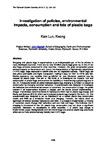Investigation of policies, environmental impacts, consumption and fate of plastic bags
| dc.contributor.author | Kwong, K-L. | |
| dc.date.accessioned | 2019-05-16T12:21:10Z | |
| dc.date.available | 2019-05-16T12:21:10Z | |
| dc.date.issued | 2014 | |
| dc.identifier.citation |
Kwong, K-L. (2014) 'Investigation of policies, environmental impacts, consumption and fate of plastic bags', The Plymouth Student Scientist, 7(1), p. 100-139. | en_US |
| dc.identifier.issn | 1754-2383 | |
| dc.identifier.uri | http://hdl.handle.net/10026.1/14053 | |
| dc.description.abstract |
Shopping with plastic bags in supermarkets is an indispensable part of life for citizens in many developed countries. There are not only 10 billion plastic bags given out in the UK but also huge amounts consumed in other countries. However, this great consumption poses adverse impacts on the environment. Due to the characteristics of high-density polyethylene (HDPE) bags, bags deposited in landfill sites are not degraded naturally. Plastic bags are also photo permeable and highly transparent, making it easy for them to mimic jelly fish. Marine organisms may consider them as jellyfish for food, Moreover, seabirds may be trapped by plastic bags. The aim of this study is to investigate the impacts, fate and consumption of plastic bags and examine the feasibility of implementing a plastic bag levy in the UK. A literature review on policy indicated plastic bag charging is sufficient to reduce its consumption by changing customer behaviour. A questionnaire was designed to investigate the behaviour and environmental concern of customers, the consumption of bags, the public concern if all supermarkets imposed a charge, and the issues around implementing a charge. Interviewees were interviewed in Sainsbury's which has no plastic bag charge, and Marks and Spencer (M & S) which has introduced a plastic bag charge in Plymouth, UK. The questionnaire was designed to set up Sainsbury's as a current plastic bag consumption model, and M&S as a simulation model after charging. However, the results show no significant difference between Sainsbury's and M&S. If a charge is implemented, a minority of customers would change their behaviour and use their own bags. This indicates that if charging is introduced in the UK, plastic bag consumption may not show a significant reduction. Moreover, in experiences in other countries, if a plastic bag charge is implemented, paper, biodegradable and non-woven bags are used as plastic bag substitutes which are no more environmentally friendly than HDPE bags. | en_US |
| dc.language.iso | en | en_US |
| dc.publisher | University of Plymouth | |
| dc.rights | Attribution 3.0 United States | * |
| dc.rights.uri | http://creativecommons.org/licenses/by/3.0/us/ | * |
| dc.subject | plastic bags | en_US |
| dc.subject | high-density polyethylene | en_US |
| dc.subject | HDPE | en_US |
| dc.subject | landfill sites | en_US |
| dc.subject | marine environment | en_US |
| dc.subject | plastic bag substitutes | en_US |
| dc.title | Investigation of policies, environmental impacts, consumption and fate of plastic bags | en_US |
| dc.type | Article | |
| plymouth.issue | 1 | |
| plymouth.volume | 7 | |
| plymouth.journal | The Plymouth Student Scientist |



